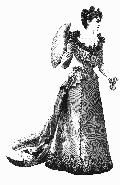
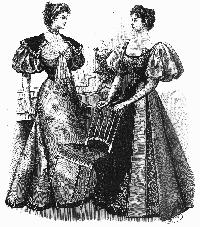
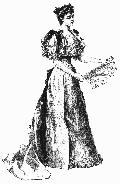
The following descriptions are given for those who wish to indulge in the period flavor of the evening. Please don't feel obliged to wear a Victorian outfit. For the ladies a modern gown, as long and as full as possible, and dress suit for the gentlemen is perfectly fine.
Ladies' evening dress of the 1890's consists of a fitted bodice with scooped or square cut neckline, usually with extravagantly large puffed sleeves, and a full length gored or A line skirt. Gowns were made up in a wide range of fabrics from heavy brocade and velvet to lightweight silk chiffon. A skirt with a train, although elegant, is not very practical for dancing. The gown can be ornamented with elaborate lace, contrasting trim, colored ribbon bows or fancy beadwork.
Ladies' Evening Gown illustrations, original period descriptions follow:

|

|

|
An evening gown of buttercup-yellow satin and dahlia-colored velvet is from Madame Buzenet of Paris. The pointed corsage has a drapery of the dark velvet around the neck, which also forms butterfly sleeves. Below this is a bertha of the satin cut in vandykes, and embroidered with gold and pearl beads done partly on velvet and partly on satin. The skirt has little pleated basques falling straight on the sides, and is trimmed with vines of embroidery in gold and beads extending down each side of the front. The foot of the skirt is cut in points, embroidered and fringed, and falling on a band of dahlia velvet. The train is draped slightly, and is ornamented on one side with a velvet panel, and on the other with two large velvet bows.
Chine-figured silk, with a light fuscia-red ground, is the material of one of the dinner gowns illustrated. A narrow scarf of bronze velvet is knotted at intervals about the edge of the skirt. The plain-fitting waist, with short puffed sleeves, has a heart-shaped decolletage, framed on the shoulders and back by a deep velvet collar edged with spangled passementerie, and draped at the front in chiffon scarfs coming from under the collar, and hanging in lace-edged ends to below the waist.
A sumptuous gown is of green velvet, with applied metallic embroidery associated with green and brown shot moire. The entire front of the skirt is of velvet, interrupted on each side by a narrow moire panel with spangled edge. The deep-folded back of the skirt is of the moire. The low-necked pointed bodice is of velvet, with drooping puffed sleeves of moire.
Moire and mousseline are charmingly combined in the graceful evening gown from Paris, of which an illustration is given herewith. The trained skirt proclaims that it is for a matron - a young chatelaine who evidently prefers to leave off her jewels when receiving her friends. The low pointed corsage is of pale-yellow moire antique. It is fitted by darts and laced in the back. All the top of the waist is mousseline de soie of the same yellow tone, drawn down from the shoulders in full folds to meet at the bust and form a ruffle below. The sleeves are each a great puff of mousseline trimmed with double jabots of the same, held by a large bow of black satin ribbon.
The train is straight and not of great length. It is of the yellow moire opening on a tablier front of mousseline de soie gathered quite full on a foundation skirt of yellow taffeta. A large rouche of the mousseline borders the foot of the transparent tablier. A bow of black sating ribbon terminates the corsage in the back, with long sash ends descending almost to the foot of the skirt.
White and Pink moire gowns similar to this model have been designed for Newport, Lenox, and other summer abiding-places. The ribbons used in some of these dresses were white in preference to black. The mousseline matches the moire in color in every instance.
Some details of evening dress bodices
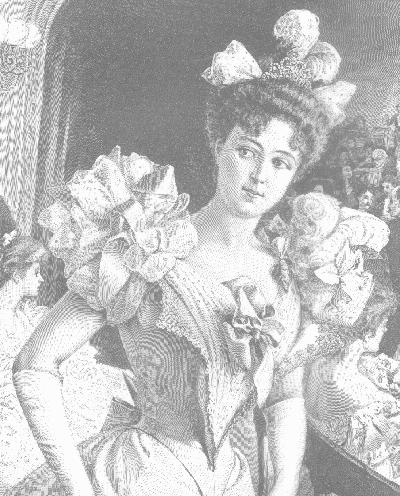
|

|
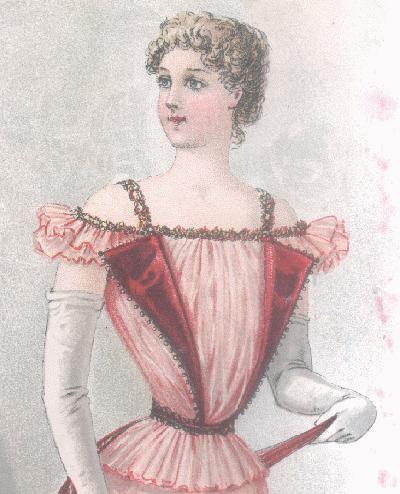
|
Hairstyles
Hair should be worn up, in a bun often fairly high on the head and was usually dressed
with small ornaments and feathers.
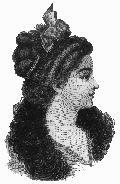
|
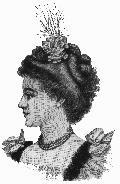
|
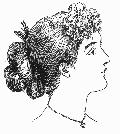
|
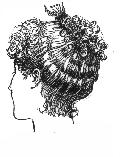
|
In this coiffure the hair is arranged in large loose waves, the front formed into a soft Pompadour and the back fluffed out at the neck. The hair is rolled into three horizontal puffs across the back, with three tiny ringlet puffs at the sides. For ornaments there are three shell combs, two close to the puffs at the sides, and one at the back. A knot of ribbon is toward the side at the top, and this holds a few artificial ringlets in place.
In this figure there is the same general arrangement, but instead of the three puffs the hair is divided into three strands, which are intertwined into a knot, the ends finishing in fluffy ringlets. A pink chiffon chou holds the stem of an aigrette.
Evening Accessories
Earrings should be dangles, and short bead necklaces
are appropriate. A large fan also makes a good summertime accessory.
Full length white gloves would complete the outfit splendidly.
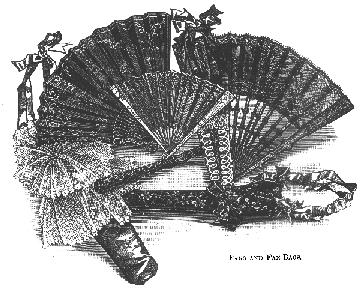
|
Shoes should be in a color to compliment the gown; those with a fairly low heel of 1-2 inches (such as Capezio character shoes), are comfortable for late Victorian dancing.
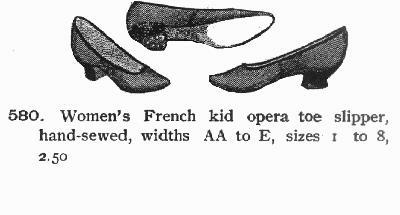
|
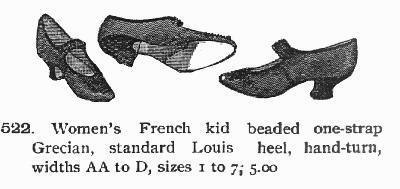
|
Gentlemen's evening dress of the 1890's is fairly similar to modern formal wear: black tail coat (the "recently" invented tuxedo jacket is also an acceptable, though less formal, alternative); white formal shirts with stand up or wing tip collar; vest (ideally with lapels and scooped-front -- cummerbunds are not period); bow tie which can be either white or black. White gloves are de rigeur for ballroom wear. Flexible soled shoes such as Capezio black jazz oxfords are suitable for dancing.
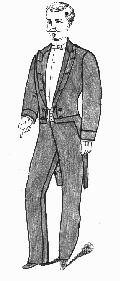
|
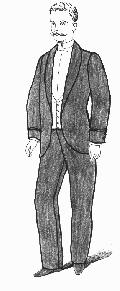
|
Folkwear Vest pattern number #222 view B (also contains a bow tie pattern), or Simplicity pattern #5436, views C or D, done in black or white are suitable for this period.
Resale, thrift or vintage clothing shops are a good source for a suitable outfit. Past Patterns ball gown #206, with the addition of full puffed sleeves and skirt patterns numbers #208 and #1097 are appropriate for 1890's evening gowns. Patterns of Fashion by Janet Arnold also has accurate ball gown patterns. Fitted day gown bodices such as Past Patterns #207 and #903 can be easily altered by cutting it with a lower neckline and shorter puffed sleeves. Laughing Moon Enterprises has good 1890's evening bodice and skirt patterns as well.
© 2003, Vintage Victorian, All rights reserved
Go to Period Fashions Reference LibraryLast updated: 8 July, 2003/csb